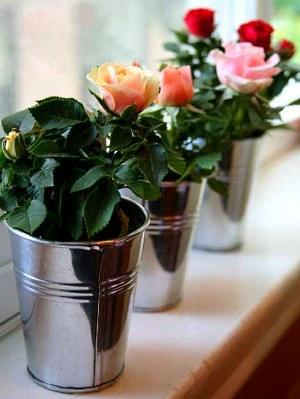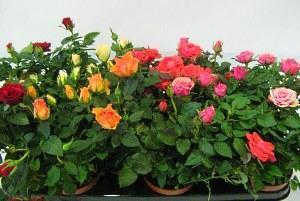How to care for a home rose?
 A home or indoor rose is a miniature (up to 50 cm high), flowering, potted plant, of which there are about 250 species, but there are many more varieties. In the photo of home roses, you can see a wide variety of colors and shapes of buds, which makes this indoor plant very attractive for growing at home.
A home or indoor rose is a miniature (up to 50 cm high), flowering, potted plant, of which there are about 250 species, but there are many more varieties. In the photo of home roses, you can see a wide variety of colors and shapes of buds, which makes this indoor plant very attractive for growing at home.
Among the varieties of home roses that are most suitable for growing as indoor plants, it is worth highlighting such as "Miss Rowena Tom", "Gruss en Teplitz" or "La France" from the variety of hybrid tea roses, "Madame Falco", "Marshal Niel" or Nifetos from the tea rose variety, the Orand Triumph from the polyanthus variety, the Bourbon Souvenir de la Malmaison, or most Bengal red roses.
Recommendations for growing conditions for home roses

And in order to have as few questions as possible about how to care for a home rose, you need to remember certain recommendations:
- to arrange pots with these plants, you need to choose southern and southeastern window openings and balconies;
- you need to plant homemade roses in fresh nutritious soil;
- in the warm season, they need to provide sufficient fresh air;
- during the growing season, indoor roses must be watered abundantly, but at the same time take into account the ambient temperature and the degree of drying of the top layer of the soil;
- in the process of caring for a home rose, it is imperative to carry out weekly feeding, especially carefully - during flowering and active growth;
- transshipment of plants in larger containers, but only if necessary.
Negative factors when growing indoor roses must also be considered. These include:
- dry air and direct sunlight, which can cause overheating;
- cold water used for irrigation;
- leaving dry foliage and stems, withered buds and sprouts on the plant;
- trauma to the roots;
- wintering in a too hot room;
- delayed treatment and control of diseases and pests.
Home care roses require constant and rather active, but provided that a favorable environment for growth is created and maintained, it will only come down to regular watering and feeding.
Care
 For home roses, care should be started from the moment of purchase. The whole process can be broken down into the procedures that must be followed:
For home roses, care should be started from the moment of purchase. The whole process can be broken down into the procedures that must be followed:
- Adaptation - while the flower gets used to the new room, it is necessary to repeat as much as possible the conditions in which the plant was before the moment of purchase in the store, including the mode of watering and feeding. At this time, it is necessary to isolate drafts and direct sunlight, use settled clean water for irrigation, and spray the leaves. You need to transplant a home rose only after it has adapted.
- Transplant - carried out after the plant gets used to the new place. It is necessary to transplant a new rose together with an earthen lump, only slightly loosening the outer layer and removing a small amount of old soil. The transplant must be carried out very carefully so that the roots remain intact.It is best to use a mixture of turf and humus soil mixed with sand (in a ratio of 4: 4: 1) and a small amount of complex fertilizers. The pot for the transplant should be several centimeters larger in diameter and 5-7 cm higher than the container in which the rose was purchased. A drain hole is required. The bottom of the pot should cover a layer of expanded clay drainage. After transplanting, the rose should be left in the shade in a cool place for a day, and then rearranged on a well-lit windowsill, but not under direct rays, with access to fresh air.
- Watering - indoor roses are very demanding to water and may even dry out due to insufficient moisture. Therefore, it is necessary to water it regularly, in the cool part of the day, at the root, on hot days more often, as the top layer of the soil dries up. Water for irrigation should be clean, separated, room temperature.
- Top dressing should also be regular, at least 2 times a month. In this case, you can use complex fertilizers according to the instructions or with a mullein. In addition to fertilizing the soil, you can use special soluble complexes for top dressing in the form of spraying. Sick and only transplanted roses do not feed.
- Preparation for wintering is also an important stage of care, as home roses hibernate like their garden "relatives", and some varieties even shed their leaves. In order for a room rose to endure this period well, you need to move it to a cool room (15-17 ° C) with sufficiently humid air and without household appliances. Also, before wintering, roses are cut, leaving 5 live buds on each branch.
- Wintering - in the autumn-winter period, roses need no less careful care, namely, watering and spraying, maintaining normal air humidity.
Home roses are very beautiful indoor plants, and despite the demanding care, they are still very popular among flower growers.
Very useful information! Thanks to her, I learned that Home Roses, which are sold in hypermarkets closer to women's holidays, can be grown at home, and not kept as cut - three or four days! Many thanks to the author for such an interesting article! I will start growing Home Roses from tomorrow! I will print these recommendations and distribute to all my girlfriends and friends! Let's breed beauty!
Whimsical, but very beautiful flowers. I studied for a long time to take care of them, I could not understand in any way why they dry. Only now I understand that the roses lacked moisture, I watered them twice a week and did not spray them at all. I want to add from myself that they do not tolerate dry hot air, so the place above the battery (on the windowsill) is not the most suitable one! Better to put them in bright sunny places.